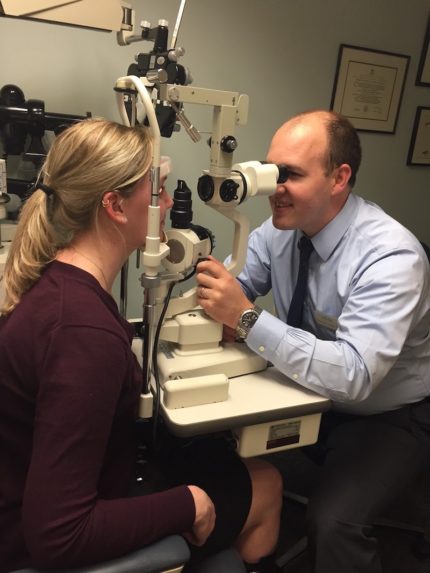So … who spends a good part of the day staring at a computer? Who stays up late working on their laptop, watching movies on their iPad, or checking Facebook and Instagram on their phones? Who reads under the covers sometimes? That’s me. And these days, it’s apt to be an iBook.
All of these behaviors beg this question: How bad are digital screens (computer monitors, tablets, smartphones) for your vision?
I asked Dr. Tim Kearins, who is an optometrist at Casco Bay Eyecare.
His response:
“I’d be happy to field that question. However, I think it’s important to parcel the question out into two parts.
1) How bad are digital screens for your vision? (clarity, focusing)
Prolonged use of devices such as tablets and smartphones have long been shown to be associated with uncomfortable symptoms – most of them visual. The most common symptoms are eyestrain, headaches, blurred vision, and neck or shoulder pain.
The extent to which an individual may experience these symptoms is largely dependent upon his/her visual abilities in relation to the visual demands of the task being performed. That is to say – it is not the screen itself directly causing symptoms – it is the fact that reading or working on a screen is a highly demanding visual task – more so than reading well-illuminated paper print.
If an individual has even a mild deficiency in their ability to focus at near, or to converge their eyes toward the screen, or to move their eyes smoothly, they will most likely experience discomfort in one way or another after a certain period of time on these screens.
So instead of saying that computer, tablet, and smartphone screens cause visual problems, it would be more accurate to say that these devices uncover or demonstrate that an individual has a visual deficiency. This, of course, can be diagnosed and addressed easily during a comprehensive exam with an eye care provider.
2) How harmful are digital screens for the tissues of the eye? (risk for eye disease)
There is mounting evidence that the light from digital screens themselves is harmful to the tissues of the eye and contributes to ocular disease. There is one area within the visible light spectrum that is harmful to the eye and that is short wavelength blue light. And our computers, tablets, and phones emit plenty of this harmful light.
Prolonged exposure to blue light has been postulated to raise one’s risk for developing macular degeneration later in life — a condition that, unfortunately, can cause blindness. Blue light exposure can also disrupt one’s circadian rhythm and interfere with sleep patterns. This is not to say that one should avoid screen time altogether.
To counter-act this harmful light, I will typically prescribe certain lenses (we call them “blue-blockers”) to be worn while working on these devices. These lenses filter out harmful short wavelength light only, which allows an individual to read or work on digital screens without the risk for ocular disease.
One more thing: Dry eyes
Another physical issue that prolonged screen time tends to cause is significant ocular dryness. When we humans blink our eyes, it is a stimulus to produce tears. Think of each blink as a wet squeegee across your windshield — rewetting and clearing the surface, refreshing it so to speak.
When we look at digital screens, our typical blink frequency decreases dramatically, leaving our eyes open for longer periods than we are used to. You know the look — that thousand yard stare into the computer. Well, while we are staring at the computer, our tears are just evaporating out into thin air, drying the corneal surface until we start to get that stinging, burning sensation.
Dry eye disease is a multifactorial condition, with multiple causes and multiple treatments. Again, these can be addressed during a comprehensive examination with an eye care provider.”
One thing I do that I thought offered some protection if I’m reading at night is to put my phone into “night mode.” It reduces the brightness of the screen and supposedly, my exposure to blue light. I’m going to follow with Dr. Kearins on that and will let you know what he says.


Leave A Comment